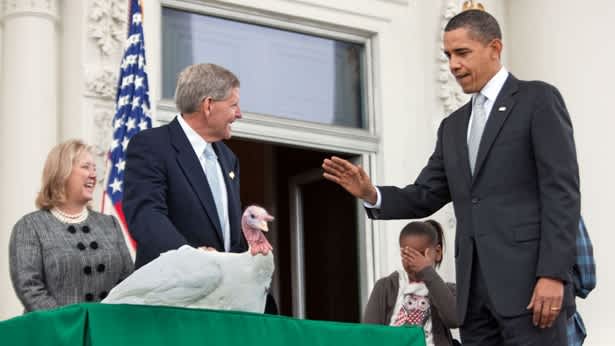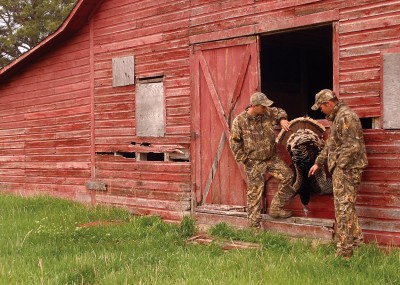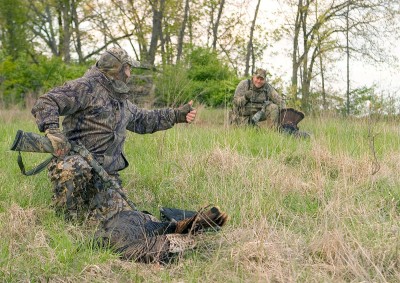“Pardon” a Wild Turkey, Mr. President
James Swan 11.21.13

On Thanksgiving eve in 1948, President Harry Truman issued a “presidential pardon” for a live turkey. This was motivated by negative feedback from 1947 September to November announcements that the government was encouraging “poultry-less Thursdays.” Prior to that some presidents did pardon turkeys, but it was not a regular event. Following Truman’s lead, succeeding presidents have continued the tradition.
The ceremonial gobblers are huge domesticated birds donated by the National Turkey Federation—turkey farmers. Typically following the pardon the bird goes to a zoo or a park. In 2012, two 40-pound birds of honor, “Cobbler” and “Gobbler,” were pardoned by President Obama and sent to Mount Vernon. The National Turkey Federation has also donated a killed bird for the President’s dinner every year since 1947.
Americans consume upwards of 240 million domestic turkeys a year. The turkey farming industry contributes $26 billion to the US economy annually, and employs between 20,000 and 25,000 people. They certainly deserve recognition. But we also consume twice that many chickens and we don’t officially honor them, let alone pigs or cattle.
The turkey is a true American bird. The domesticated ones may look a lot different in color and weight, but they are descended from wild turkeys that have been around for at least 10 million years. The Indians were the first to domesticate them, as well as hunt wild ones. When the Pilgrims and the Indians sat down to eat Thanksgiving dinner at Plymouth, Massachusetts, in 1621, they feasted on the wild turkey. The birds deserve to be honored.

In contrast to its domesticated relatives, the wild turkey is about the wariest thing on two feet. With hearing eight times better than man, it can hear a twig snap a quarter of a mile away. With eyesight five times better than man’s, a wild turkey can see the movement of a hand at 100 yards. If the turkey suspects danger, it can depart on foot at 25 mph or take to the air and speed off at 55 mph, an amazing feat for a 15- to 20-pound bird.
According to the National Wild Turkey Foundation, for years the Federation has been trying to convince presidents that in addition to the traditional pardoning of a fat, domestic turkey on the eve of Thanksgiving, he or she should also honor the wild turkey by releasing birds. So far, no luck, but in previous years lesser-known members of administrations have attended releases of wild birds.
In these times, the wild turkey remains a very positive and appropriate symbol of America. The story of the comeback of the wild turkey is an example of the best of the American conservation spirit. When the Pilgrims arrived, wild turkeys were abundant. With the introduction of firearms, unrestricted hunting, and the clearing and burning of forested land, the wild turkey population dramatically declined. By the turn of the century there were less than 30,000 wild turkeys left in the wild in the entire United States.
In 1973, when the National Wild Turkey Federation was established, there were an estimated 1.3 million wild turkeys in the country and 1.5 million wild turkey hunters. Currently, the number of US turkey hunters is approaching three million and they’re responsible for pumping some $2 billion into the economy each year.
There are now over seven million wild turkeys with five subspecies: Eastern, Osceola (Florida), Rio Grande, Merriam’s, and Gould’s. Wild turkeys are found in all states except Alaska and there are rumors of the wily birds in the southern part of the state. There is also a growing population in Canada. In some areas they have become habituated to people, they compete with pigeons for food, and you don’t want one flying into your window.

There are 390,000 members of the National Wild Turkey Federation in the United States, Canada, and 11 foreign countries. Since 1985 the National Wild Turkey Federation has raised over $412 million for over 16,000 conservation projects that have improved 17.25 million acres of habitat, which have made the wild turkey comeback a reality. The wild turkey hunters of America also deserve credit for what they’ve done, and so do the turkeys.
Thanksgiving is a time to honor the bounty of the harvest. Pardon the farm-raised bird, but why not pay tribute to one of the finest stories of American conservation and recognize one of the most striking and impressive species of wildlife in the world—the native wild turkey?
There are a number of wild turkey releases going on around the United States. It’s probably too late to have the president work in a wild turkey release into his busy schedule for this year, but maybe next year? The three million turkey hunters are also voters.
Note: There is a movement afoot to declare Black Friday, the day after Thanksgiving when Christmas shopping officially begins, as “Wild Turkey Day.” http://wildturkeyday.com/ Apparently this is not officially associated with “Wild Turkey Bourbon,” but there certainly could be a connection between the two for busy shoppers.

